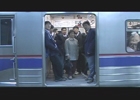By Tessa Laird
Jae Hoon Lee has been exhibiting digital artworks of ever-evolving complexity for a couple of years now. He specialises in scanning textures, from human skin to plant life to gravel and concrete. He manipulates these surfaces digitally, weaving them into strange movies. Last year, I caught his mesmerising video Leaf, which panned up a series of leafy spines, each running seamlessly into the next, and at dizzying speed, creating a green geyser of morphing species. To a soundtrack of cicadas, this piece was like a trip up the Amazon River – astonishingly lush.
For Alchemy of the Land, recently at Auckland’s Starkwhite, Lee created a curious network of lightboxes, flat-screen monitors, and a video projection, all linked horizontally by deliberately obtrusive power cords. The lightboxes – clouds on one side, a tattoo on the other (Lee’s skin fetish resurfaces), seemed to have little in common with Virtual Train Station, a video projection of a Korean subway station. But there was a unifying horizontality to the speeding trains, the power cords, and Wild Flower Ground Zero, a video of flowers panning right to left on a background of tarseal. Though it depicted flowers and stems, the inference was roots and other subterranean connectors – snaking over to the footage of the underground. I watched Wild Flower’s strange combination of fragile beauty and greying gutters for ages and didn’t see the same flower twice.
In A Wanderer, on the other side of the room, Lee let his camera become just that. The strength of Leaf and Flower came from their relentless trajectories, yet A Wanderer possessed more random delights, as the camera panned and scanned surfaces from grass to stones to ice. It felt like an exploration, as if Lee’s scanner was bringing us information every bit as otherworldly and fascinating as Rover on Mars.
Also treating the digital medium with satisfying complexity was Amanda Newall’s Sic Games at the Film Archive. The first room contained display cases of objects, beautifully crafted marbled-glass guns, alongside fun-fur relics – costumes from some kind of (sic) game. These fetishistic accoutrements were displayed next to photographs of dissipated post-teen males wearing the fur ears, capes and gloves, reminding me of “Furries” – the recognised sexual subculture that dress in furry animal costumes for love play. There was certainly an eroticism in Newall’s violently odd assortment of objects and textures.
What became increasingly apparent, while peering into the cases, was the weird, pulsating sounds permeating the room. Eventually, when I stepped into the second room, I realised that four table-top game stations were pumping incessant shots into the front room, where they became disembodied echoes. The game was Newall’s own creation, featuring stills of interiors juxtaposed with random floating objects to be shot at with a digital pistol. The speed at which this game unfolded was beyond the capabilities of my reflexes, inspiring a kind of Luddite panic. For while Lee manages to celebrate the vegetal with technology, Newall pays homage to the feral. Survival of the fittest becomes survival of the technologically hippest. The only code that operates in this world, apart from computer code, is the code of the hunter, dispassionate and hungry.
Full article originally published in the New Zealand Listener http://www.listener.co.nz April 16-22 2005 Vol 198 No 3388
© APN Holdings NZ Ltd
